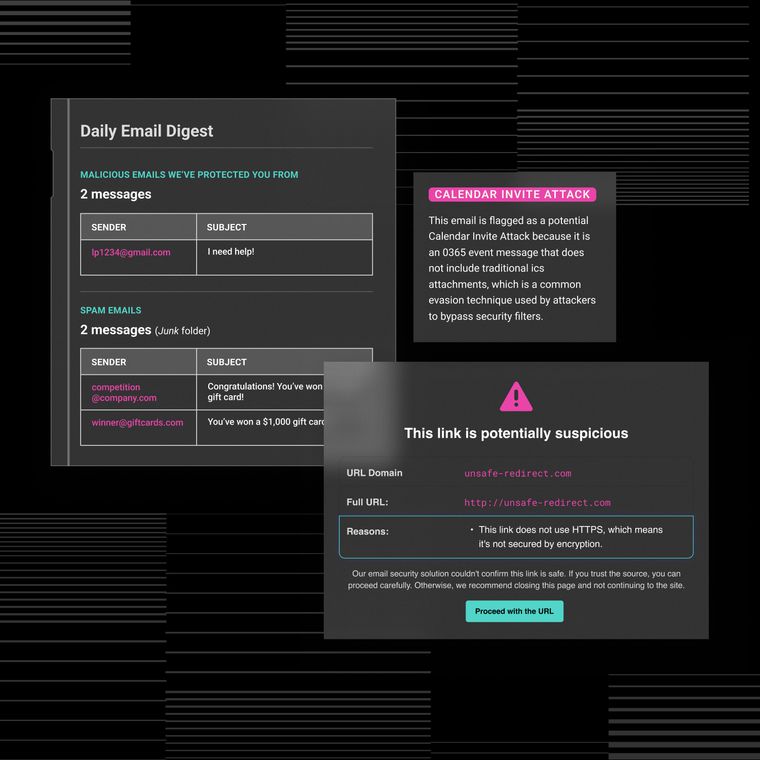10 Identity Protection Strategies for the Modern Enterprise
Strengthen your identity security with practical strategies that defend against phishing, credential theft, and insider risk.
July 15, 2025
Modern enterprises require comprehensive identity protection strategies that address the full spectrum of identity-based threats, from credential stuffing to sophisticated phishing campaigns.
Multi-factor authentication blocks 99.99 percent of credential-stuffing attempts, according to recent Microsoft research. This finding reinforces a fundamental shift in cybersecurity: identity has replaced the network edge as your primary security perimeter.
When an attacker steals an email address, lures an employee into clicking a phishing link, or leaks personal information, patchwork controls fail to provide adequate protection. Organizations need a systematic approach that prevents future incidents through proactive identity hardening and establishes clear response protocols in the event of breaches.
The ten strategies outlined here harden every phase of the identity lifecycle, from enterprise-wide MFA deployment to continuous user analytics. These proven tactics mitigate the most common attack vectors—credential stuffing, sophisticated phishing, and insider misuse—while maintaining operational efficiency. Each strategy builds toward a least-privilege, always-verified posture that modern threat actors cannot easily compromise.
1. Implement Enterprise-Wide Multi-Factor Authentication (MFA)
Rolling out additional authentication factors across every user and workload can significantly reduce your account-takeover risk and is considered one of the most impactful identity controls when combined with other layered security measures.
Multi-factor authentication adds a second verification factor—typically a mobile push, hardware key, or one-time code—so stolen passwords alone no longer grant access.
Microsoft research shows that enforcing MFA blocked 99.99 percent of credential-stuffing attempts and drove a 99.22 percent reduction in overall compromise risk, even when passwords had already been leaked.
App-based prompts deliver the strongest defense; yet, the same research shows that SMS codes still neutralize the vast majority of attacks—any second factor is dramatically safer than none.
To implement effectively, enable additional authentication by default for every user, contractor, and service account. Prioritize app-based or FIDO2 authenticators while phasing out voice and email codes.
Disable legacy protocols that bypass modern auth (IMAP, POP, SMTP Basic) and monitor enrollment dashboards while auto-enforcing registration for stragglers. Feed authentication logs into your SIEM so anomalous challenges trigger automated response.
2. Adopt a Zero-Trust, Identity-Centric Architecture
Zero Trust eliminates the traditional security perimeter by treating every access request as potentially hostile, regardless of location or user credentials. This architecture places identity at the center of all security controls, enforcing continuous verification before granting access to any resource.
The core Zero Trust principles create a comprehensive security framework. Least privilege access grants minimal permissions required for specific tasks, while continuous verification validates identity and device state throughout each session. Contextual awareness factors device health, location, and behavioral patterns into access decisions, and micro-segmentation isolates network segments to prevent lateral movement.
Implementation starts with comprehensive risk baselining. Ingest identity, endpoint, and network telemetry into behavioral analytics platforms to establish normal user and device patterns. Create conditional access policies that automatically escalate authentication requirements or block access when high-risk identities target sensitive data.
Align your Zero Trust practices with NIST SP 800-207 standards and Microsoft's recommended Zero Trust principles. This framework enables continuous monitoring, adaptive access controls, and automated threat remediation across your entire infrastructure.
3. Deploy Privileged Access Management (PAM) for High-Risk Identities
PAM transforms your most dangerous attack surface by granting elevated rights only when needed, monitoring every session, and securing credentials in hardened vaults. Many programs stall because restrictive controls slow work, or sprawling cloud estates obscure who actually holds admin power—driving administrative overhead and user frustration.
A modern platform addresses these challenges with just-in-time elevation, real-time session recording, automated credential rotation, and mandatory secondary authentication at checkout. Pairing these capabilities with a tight operational rhythm keeps risk and pushback low.
To implement effectively, inventory every human, service, and API account with elevated rights. Remove standing admin access and require time-boxed elevation instead. Stream PAM logs to your SIEM for unified threat hunting and review and certify permissions at least quarterly.
Executed consistently, PAM turns privileged identities from your biggest liability into a measurable control point.
4. Leverage User & Entity Behaviour Analytics (UEBA) to Detect Anomalies
UEBA detects compromised accounts and insider threats by continuously comparing user and entity activities against learned behavioral baselines. Machine learning models analyze login patterns, data access, and system interactions to flag anomalies—like a finance user downloading gigabytes at 2 a.m. or a service account authenticating from an unfamiliar country—before damage spreads.
Effective deployment requires comprehensive data integration. Connect logs from Active Directory, VPN, cloud applications, and endpoint systems so the platform sees complete user journeys.
Normalize and enrich this telemetry for analysis, then allow the system a learning phase to establish peer-aware baselines. Adaptive models continuously refine these baselines to reduce false positives while maintaining detection accuracy.
Define clear detection objectives and tune risk scoring thresholds based on your environment. Route high-severity alerts directly to your SOAR platform for automated containment actions. Many security teams now auto-isolate anomalous sessions or trigger step-up authentication in real time, creating an immediate response to suspicious behavior.
Abnormal extends this approach by layering advanced behavioral AI on top of UEBA signals, providing richer context and reducing alert noise. This combination gives security teams actionable intelligence rather than overwhelming them with false positives.
5. Harden Machine Identities & Automate Certificate Lifecycle Management
Machine identities require the same rigorous management as user accounts—neglect them and face outages or silent breaches. SSL/TLS certificates, SSH keys, and API tokens authenticate servers, containers, and workloads so they can trust one another. A single expired certificate can take down critical services; a forgotten key hands attackers a foothold.
NIST SP 1800-16 and CIS Controls both emphasize the importance of full lifecycle governance, and real-world incidents validate why. Start with discovery: scan every environment and build a central inventory with explicit ownership.
Automate issuance and renewal so certificates are replaced before they lapse. Platforms that issue short-lived, policy-driven certificates dramatically shrink the attack window.
Regular key rotation and strong encryption standards restrict adversary options, while continuous monitoring flags anomalies in real time. Establish working groups to set policy, track coverage metrics, and audit results. Tie alerts and telemetry into your SIEM so every certificate event sits alongside user activity.
When you automate each stage—discover, issue, rotate, retire—you eliminate the blind spots attackers exploit. The goal is seamless operation where machine identities self-manage within defined security boundaries.
6. Enforce Modern Password & Secrets Management Policies
Password policies remain critical to identity security architecture, serving as the foundation for credential protection while you transition to passwordless authentication. Follow NIST 800-63B guidance by requiring passphrases of at least 8 characters while eliminating periodic password resets that encourage dangerous reuse patterns.
Centralize all human and machine credentials in an enterprise-grade vault instead of spreadsheets or source code repositories. This approach provides immutable audit trails, policy-based access controls, and automated rotation capabilities that extend to API keys, service-account credentials, and cloud tokens.
Integrate your vault directly with CI/CD pipelines and infrastructure-as-code workflows so developers never handle raw secrets. Implement just-in-time access patterns that grant tokens only when builds or scripts require them, then immediately revoke access. Automate high-risk credential rotation on a 90-day schedule and maintain tamper-evident logging for compliance validation.
Monitor vault telemetry to identify credential misuse early and trigger rapid remediation workflows.
7. Automate Joiner-Mover-Leaver (JML) Workflows
Automating joiner-mover-leaver workflows eliminates permission creep and orphaned accounts before they become security gaps. JML manages the complete identity lifecycle—creating accounts on day one, adjusting access when roles change, and fully decommissioning accounts when employees leave.
Connect your identity and access management platform directly to your HR information system. New hires inherit the correct roles automatically, and any job change triggers immediate permission updates. This eliminates the manual handoffs that create security holes.
Schedule quarterly reconciliation reviews to verify that actual entitlements still match HR records. Set a strict 24-hour deprovisioning target for departing employees—anything longer leaves your organization exposed to insider threats.
The payoff is immediate: tighter security posture, cleaner compliance audits, and significantly reduced manual IT overhead. Your security team stops chasing orphaned accounts, and your IT department stops fielding access requests that should have been automated from the start.
8. Map Identity Controls to Regulatory & Industry Compliance
Identity governance converts compliance requirements into automated, repeatable workflows that satisfy auditors and reduce manual overhead.
Direct control mapping shows how your identity controls address multiple regulations simultaneously. Advanced authentication, PAM, UEBA, and JML workflows directly address control families across SOX access reviews, HIPAA user identification requirements, PCI DSS authentication restrictions, and GDPR data minimization mandates.
Build your compliance matrix by creating a four-column structure: regulation, specific clause, supporting identity control, and system-generated evidence. PAM session recordings, authentication logs, and UEBA alerts provide audit-ready documentation.
Automate evidence collection by feeding identity logs into your SIEM and scheduling automated export reports before audits. This eliminates manual evidence gathering and accelerates certification renewals while maintaining continuous compliance posture.
9. Deliver Continuous Security Awareness & Phishing Simulations
Technical safeguards only succeed when every employee recognizes a phishing link and acts accordingly, requiring a training program that runs continuously, adapts to each role, and measures real-world behavior. Map curricula to job functions: finance teams drill on invoice fraud, developers rehearse supply-chain impersonations, and executives practice spear-phishing spotting.
Layer live phishing simulations into daily email traffic, then follow each click or report with just-in-time coaching that explains what was missed. Track outcomes—fewer reported credential prompts, faster incident reporting—to prove reduced susceptibility over time.
Abnormal's AI Phishing Coach automates these interactions, surfaces individual risk trends, and feeds results back into your broader identity analytics pipeline, ensuring human vigilance evolves alongside technical controls.
10. Integrate Identity Signals with SIEM/SOAR for Rapid Response
Consolidating identity telemetry in your SIEM and orchestrating automated responses through SOAR transforms raw signals into immediate, decisive action. Stream high-value logs—authentication challenges, PAM session data, UEBA risk scores—into central platforms like Splunk or Microsoft Sentinel using native connectors. This enables entity behavior analytics that correlates login anomalies with network and endpoint events to surface true positives faster.
Trigger SOAR playbooks that isolate risky sessions, disable tokens, or force password resets without analyst intervention once signals land in your SIEM. Microsoft Sentinel can enrich an alert with UEBA context, open a ticket, and call a Cortex XSOAR workflow to revoke cloud entitlements within seconds.
This unified approach delivers three critical outcomes:
Reduced dwell time through immediate threat response
Eliminated manual toil via automated workflows
Enhanced threat hunting by freeing analysts from repetitive triage tasks.
By unifying collection, correlation, and automation, security teams shift from reactive response to proactive threat hunting.
Stop Identity-Based Attacks Before They Start
The strategies outlined above form a strong foundation for identity defense, but true protection requires more than checklists and controls. Abnormal AI brings intelligence and automation to every layer of identity security by learning the unique behavioral patterns of your users, vendors, and machines.
This behavioral layer detects subtle deviations, like a compromised account forwarding invoices, a token used from an unusual location, or a phishing link embedded in a known supplier’s message.
Abnormal integrates with your existing stack—MFA, PAM, UEBA, SIEM—without agents or disruption. It adds context to identity signals, blocks malicious activity in real time, and eliminates the manual triage that slows down response. See a personalized demo to see how Abnormal transforms identity security from reactive to truly proactive.
Related Posts
Get the Latest Email Security Insights
Subscribe to our newsletter to receive updates on the latest attacks and new trends in the email threat landscape.


